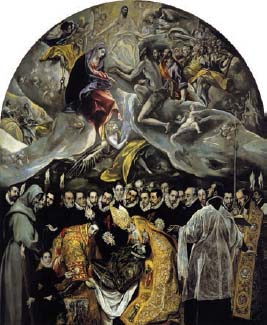The Early Modern World, C. 1300–1600Sixteenth-Century European Art and Architecture |
How can El Greco’s paintings appear so modern? |
To some, the paintings of El Greco appear more closely related to nineteenth-century impressionism or twentieth-century expressionism than the sixteenth-century Spanish styles of nearly five hundred years earlier. His work is characterized by loose brushstrokes, often ghostly, elongated figures, and a use of colors in line with the Mannerists. El Greco’s real name was Domenikos Theotokopoulos and “El Greco” means “the Greek” in Spanish. Born in Crete in 1541, he worked in Italy before arriving in Toledo, Spain, with the unfulfilled goal of becoming an artist in the court of Philip II. Although the king didn’t favor El Greco, he did find many other patrons. His 1586 painting The Burial of Count Orgaz, depicts the soul of the dead count as it rises to heaven, accompanied by an angel, and surrounded by an audience of saints, holy figures, and well-known individuals from Toledo. The figures are pale, ghostly, and white, which contrasts with the bright yellows worn by the clergy and the red fabrics worn by the Virgin Mary in heaven. The painting is arguably similar in style to Italian mannerists such as Pontormo, and El Greco is considered by some to be a Mannerist painter.

The sixteenth century artist El Greco worked primarily in Toledo, Spain. The Burial of the Count of Orgaz (1586), which depicts the laying to rest of a generous, pious man in the presence of heavenly figures, is one of El Greco’s most famous works.
